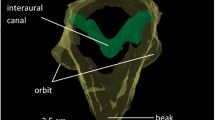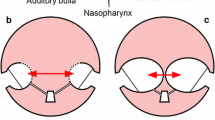Abstract
Whereas it is clear from anatomical studies that all birds have complex interaural canals connecting their middle ears, the effect of interaural coupling on directional hearing has been disputed. A reason for conflicting results in earlier studies may have been that the function of the tympanic ear and hence of the interaural coupling is sensitive to variations in the intracranial air pressure. In awake birds, the middle ears and connected cavities are vented actively through the pharyngotympanic tube. This venting reflex seems to be suppressed in anesthetized birds, leading to increasingly lower pressure in the interaural cavities, stiffening the eardrums, and displacing them medially. This causes the sensitivity, as well as the interaural coupling, to drop. Conversely, when the middle ears are properly vented, robust directional eardrum responses, most likely caused by internal coupling, have been reported. The anatomical basis of this coupling is the ‘interaural canal,’ which turns out to be a highly complex canal and cavity system, which we describe for the zebra finch. Surprisingly, given the complexity of the interaural canals, simple models of pipe-coupled middle ears fit the eardrum directionality data quite well, but future models taking the complex anatomy into consideration should be developed.










Similar content being viewed by others
Abbreviations
- B:
-
Bullae
- HMOT:
-
Hypomedial-orbital tube
- IAA:
-
Interaural arc
- IAC:
-
Interaural canal
- IBP:
-
Inter-bullae passage
- ICA:
-
Intracranial air
- ICE:
-
Internally coupled ears
- LDV:
-
Laser Doppler vibrometry
- MOC:
-
Medio-orbital canal
- PTO:
-
Paratympanic organ
- SAOS:
-
Superoantero-orbital sinus
- SLOC:
-
Superolatero-orbital canals
References
Amin N, Doupe A, Theunissen FE (2007) Development of selectivity for natural sounds in the songbird auditory forebrain. J Neurophysiol 97:3517–3531. doi:10.1152/jn.01066.2006
Baumel JJ, Witmer LM (1993) Osteologia. In: Baumel JJ, King AS, Breazile JE, Evans HE, Vanden Berge JC (eds) Handbook of Avian Anatomy. Nomina anatomica avium, 2nd edn. Publications of the Nuttall Ornithological, Cambridge, pp 45–132
Beranek LL (1993) Acoustic measurements. Wiley, New York
Bierman HS, Thornton JL, Jones HG, Koka K, Young BA, Brandt C, Christensen-Dalsgaard J, Carr CE, Tollin DL (2014) Biophysics of directional hearing in the American alligator (Alligator mississippiensis). J Exp Biol 217:1094–1107. doi:10.1242/jeb.092866
Calford MB (1988) Constraints on the coding of sound frequency imposed by the avian interaural canal. J Comp Physiol A 162:491–502. doi:10.1007/BF00612514
Calford MB, Piddington RW (1988) Avian interaural canal enhances interaural delay. J Comp Physiol A 162:503–510. doi:10.1007/BF00612515
Carr CE, Bierman H, Christensen-Dalsgaard J (2015) Coupled ears in lizards and crocodilians. Biol Cybernet (This issue)
Christensen-Dalsgaard J (2011) Vertebrate pressure-gradient receivers. Hear Res 273:37–45. doi:10.1016/j.heares.2010.08.007
Christensen-Dalsgaard J, Manley GA (2005) Directionality of the lizard ear. J Exp Biol 208:1209–1217. doi:10.1242/jeb.01511
Counter SA, Borg E (1979) Physiological activation of the stapedius muscle in Gallus gallus. Acta Otolaryngol 88:13–19. doi:10.3109/00016487909137134
Counter SA, Borg E (1982) The avian stapedius muscle. Influence on auditory sensitivity and sound transmission. Acta Otolaryngol 94:267–274. doi:10.3109/00016488209128913
Cracraft J (1968) The lacrimal-ectethmoid bone complex in birds: a single character analysis. Am Midl Nat 80:316–359. doi:10.2307/2423530
Croll DA, Gaston AJ, Burger AE, Konnoff D (1992) Foraging behavior and physiological adaptation for diving in Thick-billed Murres. Ecology 73:344–356. doi:10.2307/1938746
Doyle WJ, Seroky JT, Alper CM (1995) Gas exchange across the middle ear mucosa in monkeys: Estimation of exchange rate. Arch Otolaryngol Head Neck Surg. 121:887–892. doi:10.1001/archotol.1995.01890080055011
Fletcher NH (1992) Acoustic systems in biology. Oxford University Press, New York
Jensen KK, Christensen-Dalsgaard J, Suthers RA, Larsen ON (2010) A newly discovered supero-antero-orbital sinus connecting to the interaural canal may play a role in zebra finch hearing. In: Proceedings of the IX international conference Neuroethol, p 146
Jørgensen JM (1984) Fine structure of the paratympanic organ in the avian middle ear. Acta Zool 65:89–94. doi:10.1111/j.1463-6395.1984.tb00813.x
Kania R, Portier F, Lecain E, Marcusohn Y, Ar A, Herman P, Huy PTB (2004) Experimental model for investigating trans-mucosal gas exchanges in the middle ear of the rat. Acta Oto-laryngol 124:408–410. doi:10.1080/00016480310000683
Kanick SC, Doyle WJ (2005) Barotrauma during air travel: predictions of a mathematical model. J Appl Physiol 98:1592–1602. doi:10.1152/japplphysiol.00974.2004
Klump GM, Larsen ON (1992) Azimuthal sound localization in the European starling (Sturnus vulgaris): I. physical binaural cues. J Comp Physiol A 170:243–251. doi:10.1007/BF00196906
Kreithen ML, Keeton WT (1974) Detection of changes in atmospheric pressure by the homing pigeon, Columba livia. J Comp Physiol 89:73–82. doi:10.1007/BF00696164
Kreithen ML, Quine DB (1979) Infrasound detection by the homing pigeon: a behavioral audiogram. J Comp Physiol 129:1–4. doi:10.1007/BF00679906
Larsen ON (2004) Does the environment constrain avian sound localization? An Acad Bras Cienc 76:267–273. doi:10.1590/S0001-37652004000200013
Larsen ON, Michelsen A (1978) Biophysics of the ensiferan ear III. The cricket ear as a four-input system. J Comp Physiol 123:217–227. doi:10.1007/BF00656874
Larsen ON, Popov AV (1995) The interaural canal does enhance directional hearing in quail (Aves; Coturnix Coturnix japonica). In: Burrows M, Matheson T, Newland PL, Schupe H (eds) Nervous Systems and Behaviour. Proceedings of the 4th International Congress of Neuroethology. Georg Thieme Verlag, New York p 313
Larsen ON, Dooling RJ, Michelsen A (2006) The role of pressure difference reception in the directional hearing of budgerigars (Melopsittacus undulatus). J Comp Physiol A 192:1063–1072. doi:10.1007/s00359-006-0138-1
Larsen ON, Dooling RJ, Ryals BM (1997) Roles of intracranial air pressure in bird audition. In: Lewis ER, Long JR, Lyon RF et al (eds) Divers. Audit. Mech, World Scientific, Singapore, pp 11–17
Larsen ON, Salomon R, Jensen KK, Christensen-Dalsgaard J (2014) Cave crawling in zebra finch skulls: Which anatomical structures constitute the functional interaural canal? In: Proceedings of the XI International Conference Neuroethol, p 20
Lewis B, Coles R (1980) Sound localization in birds. TINS 3:102–105. doi:10.1016/0166-2236(80)90040-5
Michelsen A, Larsen ON (2008) Pressure difference receiving ears. Bioinspir Biomim 3:011001. doi:10.1088/1748-3182/3/1/011001
Michelsen A, Larsen ON (2014) Directional hearing in insects and other small animals: the physics of pressure-difference receiving ears. In: Popper AR, Fay RS (eds) Perspectives in Auditory Research, vol 50. Springer Handbook of Auditory Research, Berlin, pp 343–359. doi:10.1007/978-1-4614-9102-6_19
Nelson BS, Suthers RA (2004) Sound localization in a small passerine bird: discrimination of azimuth as a function of head orientation and sound frequency. J Exp Biol 207:4121–4133. doi:10.1242/jeb.01230
Oeckinghaus H, Schwartzkopff J (1983) Electrical and acoustical activation of the middle ear muscle in a songbird. J Comp Physiol 150:61–67. doi:10.1007/BF00605288
Parker T, Jeffrey A (1990) Manual of Zoology. The MacMillan Company, New York
Rosowski JJ, Saunders JC (1980) Sound transmission through the avian interaural pathways. J Comp Physiol A 136:183–190. doi:10.1007/BF00657532
Ryals BM, Dooling RJ, Westbrook E, Dent ML, MacKenzie A, Larsen ON (1999) Avian species differences in susceptibility to noise exposure. Hearing Res 131:71–88. doi:10.1016/S0378-5955(99)00022-2
Schwartzkopff J (1949) Über Sitz und Leistung von Gehör und Vibrationssinn bei Vögeln. Z Vergl Physiol 31:527–608. doi:10.1007/BF00348361
Schwartzkopff J (1952) Untersuchungen über die Arbeitsweise des Mittelohres und das Richtungshören der Singvögel unter Verwendung von Cochlea-Potentialen. Z Vergl Physiol 34:46–68. doi:10.1007/BF00298942
Starck JM (1995) Comparative anatomy of the external and middle ear of palaeognathous birds. In: Beck F, Hild W, Kriz W, Pauly JE, Sano Y, Schiebler TH (eds) Advances in anatomy, embryology and cell biology, vol 131. Springer-Verlag, Berlin Heidelberg. doi:10.1007/978-3-642-79592_1 pp 1-137
Vedurmudi AP, Goulet J, Christensen-Dalsgaard J, Young BA, Williams R, van Hemmen JL (2016) How internally coupled ears generate temporal and amplitude cues for sound localization. Phys Rev Lett 116:028101. doi:10.1103/PhysRevLett.116.028101
Von Bartheld CS, Giannessi F (2011) The paratympanic organ: a barometer and altimeter in the middle ear of birds? J Exp Zool Mol Dev Evol 316:402–408. doi:10.1002/jez.b.21422
Vossen C, Christensen-Dalsgaard J, van Hemmen JL (2010) Analytical model of internally coupled ears. J Acoust Soc Am 128:909–918. doi:10.1121/1.3455853
Wada Y (1924) Beiträge zur vergleichenden Physiologie des Gehörorganes. Pflügers Arch 202:46–69. doi:10.1007/BF01723478
Witmer LM (1990) The craniofacial air sac system of Mesozoic birds (Aves). Zool J Linn Soc 100:327–378. doi:10.1111/j.1096-3642.1990.tb01865.x
Yazaki T, Tashiro Y, Biwa T (2007) Measurements of sound propagation in narrow tubes. Proc R Soc A 463:2855–2862. doi:10.1098/rspa.2007.1897
Acknowledgments
We gratefully acknowledge the financial support from the Danish Council for Independent Research Natural Sciences, the Carlsberg Foundation, and the OTICON Foundation and thank two anonymous reviewers for helpful suggestions to improve the manuscript.
Author information
Authors and Affiliations
Corresponding author
Additional information
This article is published as part of the Special Issue on Internally Coupled Ears.
Electronic supplementary material
Below is the link to the electronic supplementary material.
Supplementary material 1 (mp4 9144 KB)
Supplementary material 2 (mp4 17596 KB)
Rights and permissions
About this article
Cite this article
Larsen, O.N., Christensen-Dalsgaard, J. & Jensen, K.K. Role of intracranial cavities in avian directional hearing. Biol Cybern 110, 319–331 (2016). https://doi.org/10.1007/s00422-016-0688-4
Received:
Accepted:
Published:
Issue Date:
DOI: https://doi.org/10.1007/s00422-016-0688-4




